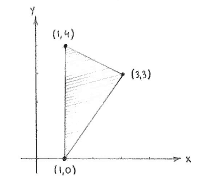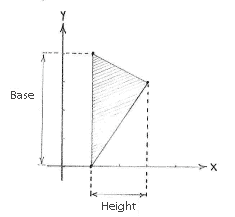Solution 2.2:9a
From Förberedande kurs i matematik 1
m |
|||
| Line 1: | Line 1: | ||
| - | We can start by drawing the points | + | We can start by drawing the points (1,4), (3,3) and (1,0) in a coordinate system and draw lines between them, so that we get a picture of how the triangle looks like. |
| - | + | ||
| - | + | ||
| - | and | + | |
| - | + | ||
| - | in a coordinate system and draw lines between them, so that we get a picture of how | + | |
| - | {{NAVCONTENT_START}} | ||
[[Image:2_2_9_a-1(2).gif|center]] | [[Image:2_2_9_a-1(2).gif|center]] | ||
| - | {{NAVCONTENT_STOP}} | ||
If we now think of how we should use the fact that the area of a triangle is given by the formula | If we now think of how we should use the fact that the area of a triangle is given by the formula | ||
| - | + | {{Displayed math||<math>\text{Area} = \frac{1}{2}\cdot\text{(base)}\cdot\text{(height),}</math>}} | |
| - | <math>\frac{1}{2} | + | |
| - | (base) | + | |
| - | it is clear that it is most appropriate to use the edge from | + | it is clear that it is most appropriate to use the edge from (1,0) to (1,4) as the base of the triangle. The base is then parallel with the ''y''-axis and we can read off its length as the difference in the ''y''-coordinate between the corner points (1,0) and (1,4), i.e. |
| - | + | ||
| - | to | + | |
| - | + | ||
| - | as the base of the triangle. | + | |
| - | The base is then parallel with the y-axis and we can read off its length as the difference in the | + | |
| - | + | {{Displayed math||<math>\text{base} = 4-0 = 4\,\textrm{.}</math>}} | |
| - | - | + | |
| - | + | ||
| - | + | ||
| - | + | ||
| - | + | In addition, the triangle's height is the horizontal distance from the third corner point (3,3) to the base and we can read that off as the difference in the ''x''-direction between (3,3) and the line <math>x=1</math>, i.e. | |
| - | + | ||
| - | In addition, the triangle's height is the horizontal distance from the third corner point | + | |
| - | + | ||
| - | to the base and we can read that off as the difference in the | + | |
| - | + | ||
| - | -direction between | + | |
| - | + | ||
| - | and the line | + | |
| - | <math>x=1</math>, i.e. | + | |
| - | + | {{Displayed math||<math>\text{height} = 3-1 = 2\,\textrm{.}</math>}} | |
| - | <math>=3-1=2</math> | + | |
| - | {{NAVCONTENT_START}} | ||
[[Image:2_2_9_a-2(2).gif|center]] | [[Image:2_2_9_a-2(2).gif|center]] | ||
| - | {{NAVCONTENT_STOP}} | ||
Thus, the triangle's area is | Thus, the triangle's area is | ||
| - | + | {{Displayed math||<math>\text{Area} = \tfrac{1}{2}\cdot\textrm{(base)}\cdot\textrm{(height)} = \tfrac{1}{2}\cdot 4\cdot 2 = 4\,\text{u.a.}</math>}} | |
| - | <math>\ | + | |
| - | (base) | + | |
| - | + | ||
| - | + | ||
Current revision
We can start by drawing the points (1,4), (3,3) and (1,0) in a coordinate system and draw lines between them, so that we get a picture of how the triangle looks like.
If we now think of how we should use the fact that the area of a triangle is given by the formula
| \displaystyle \text{Area} = \frac{1}{2}\cdot\text{(base)}\cdot\text{(height),} |
it is clear that it is most appropriate to use the edge from (1,0) to (1,4) as the base of the triangle. The base is then parallel with the y-axis and we can read off its length as the difference in the y-coordinate between the corner points (1,0) and (1,4), i.e.
| \displaystyle \text{base} = 4-0 = 4\,\textrm{.} |
In addition, the triangle's height is the horizontal distance from the third corner point (3,3) to the base and we can read that off as the difference in the x-direction between (3,3) and the line \displaystyle x=1, i.e.
| \displaystyle \text{height} = 3-1 = 2\,\textrm{.} |
Thus, the triangle's area is
| \displaystyle \text{Area} = \tfrac{1}{2}\cdot\textrm{(base)}\cdot\textrm{(height)} = \tfrac{1}{2}\cdot 4\cdot 2 = 4\,\text{u.a.} |


